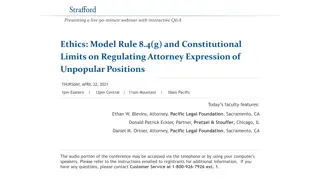
Enhancing Shade and Tree Retention Guidelines in Idaho Forests
In the context of a Shade Rule Redesign project, perspectives on field practice, public comment feedback, and shade loss study support the effectiveness of proposed tree retention options near Class I streams. The outlined options aim to maintain shade and recruit woody debris by defining tree retention requirements based on distance from stream banks, aiming to balance simplicity and effectiveness in forest management. The content delves into forest types in Idaho and the contribution of different tree species to relative stocking per acre calculations.
Download Presentation

Please find below an Image/Link to download the presentation.
The content on the website is provided AS IS for your information and personal use only. It may not be sold, licensed, or shared on other websites without obtaining consent from the author. If you encounter any issues during the download, it is possible that the publisher has removed the file from their server.
You are allowed to download the files provided on this website for personal or commercial use, subject to the condition that they are used lawfully. All files are the property of their respective owners.
The content on the website is provided AS IS for your information and personal use only. It may not be sold, licensed, or shared on other websites without obtaining consent from the author.
E N D
Presentation Transcript
Shade Rule Redesign Hawk Stone Gary Hess FPAC January 31 2020
Perspectives FIELD PRACTICE The rule is cumbersome The rule is confusing The rule is imprecise PUBLIC COMMENT The rule is difficult The rule is complicated The rule is hard to understand SHADE STUDY The rule is effective The rule is protective The rule keeps shade loss <10%
WHAT IF? Adjacent to all Class I streams, to maintain and enhance shade and large woody debris recruitment, landowners must comply with one of the two following options defining tree retention. The Relative Stocking per acre (RS) referenced in the options is calculated according to the relative-stocking-contribution table in Subsection 030.07.e.ii. (3-20-14) (1) Option 1: Within twenty-five (25) feet from the ordinary high water mark on each side of the stream, live conifers and hardwoods will be retained to maintain a minimum relative stocking per acre of sixty (60). A relative stocking per acre of thirty (30) must be retained in the stream protection zone between twenty-five (25) feet and seventy-five (75) feet from the ordinary high water mark on both sides of the stream. (2) Option 2: Within fifty (50) feet from the ordinary high water mark on each side of a stream, live conifers and hardwoods will be retained to maintain a minimum relative stocking per acre of sixty (60). A relative stocking per acre of ten (10) must be retained in the stream protection zone between fifty (50) feet and seventy- five (75) feet from the ordinary high water mark on both sides of the stream. (3-20-14) (3) Only one (1) option may be implemented within the stream protection zones of a harvesting unit covered by a single notification. Landowners are strongly encouraged to retain all trees immediately adjacent to the stream. (3-20-14) Forest Type NIGF (North Idaho Grand Fir) CIGF (Central Idaho Grand Fir) SIGF (Southern Idaho Grand Fir) WHSF (Western Hemlock-Subalpine Fir)0.123 DFPP (Douglas-fir-Ponderosa Pine) 4-7.9" 0.097 0.113 0.136 Per Tree Contribution to Relative Stocking by Diameter Class Diameter Class (DBH in inches) 8-11.9" 12-15.9" 0.209 0.347 0.244 0.405 0.293 0.486 0.267 0.442 0.326 0.54 16-19.9" 0.506 0.59 0.708 0.644 0.787 20-23.9" 0.683 0.797 0.957 0.87 1.063 24-27.9" 0.878 1.024 1.229 1.117 1.366 28-31.9" 1.088 1.27 1.524 1.385 1.693 0.151 24. Forest Type. Five forest types in Idaho are defined as follows: a. North Idaho grand fir/western red cedar (NIGF): moist to wet interior forests with western red cedar, western hemlock, and grand fir being primary climax species, found in forests north of the Clearwater/ and Lochsa Rivers. (3-20-14) b. Central Idaho grand fir/western red cedar (CIGF): productive conifer forests found in forests between the Lochsa River Basin and the Salmon River, characterized by stands having western red cedar and grand fir as climax species, with a mixed-conifer overstory increasingly comprised of ponderosa pine, Douglas-fir, and larch in the river breaks canyon-lands. Stocking levels are generally lower than that of the NIGF stands. (3-20-14) c. South Idaho grand fir (SIGF): mixed-conifer forests, dominated by ponderosa pine and Douglas-fir, found south of the Salmon River with grand fir and occasionally western red cedar being the stand climax species. d. Western hemlock-subalpine fir (WH): higher-elevation, moist, cool interior forests dominated by western hemlock, mountain hemlock, and/or subalpine fir. (3-20-14) e. Douglas-fir-ponderosa pine (PP): drier forests dominated by ponderosa pine and Douglas-fir, generally found in lower-elevation, dry sites. (3-20-14) (3-20-14) (3-20-14)
Step 1 Use Only 60/30 Option Benefits: 60 60 10 Simplicity 35 Resource protection 60 30 30 Closer to the science Doesn t limit harvest Encourages deeper SPZ management Avoids one particular problematic harvest type
Step 2 Convert to Tree Count Idea: Work backwards set an RS target (60) and convert to trees per acre: Tree count per acre for RS of 60 Tree count per acre for RS of 60 Per-tree contribution to RS (per acre) 4 - 7.9 0.097 8 - 11.9 0.209 12 - 15.9 0.347 16 - 19.9 0.506 20 - 23.9 0.683 24 - 27.9 0.878 > 28 619 619 287 287 173 173 119 119 88 88 68 68 55 55 NIGF 1.088 CIGF 0.113 531 531 0.244 246 246 0.405 148 148 0.590 102 102 0.797 75 75 1.024 59 59 1.270 47 47 SIGF 0.136 441 441 0.293 205 205 0.486 123 123 0.708 85 85 0.957 63 63 1.229 49 49 1.524 39 39 488 488 225 225 136 136 93 93 69 69 54 54 43 43 0.123 0.267 0.442 0.644 0.870 1.117 1.385 WHSF 0.151 397 397 0.326 184 184 0.540 111 111 0.787 76 76 1.063 56 56 1.366 44 44 1.693 35 35 DFPP
Step 3 Take out Tree Diameters Weighted tree count per acre: 619 in NIGF, 531 in CIGF, 441 in SIGF, 488 in WHSF, 397 in DFPP. Tree count per acre for RS of 60 Tree count per acre for RS of 60 4 - 7.9 619 619 1.00 1.00 8 - 11.9 287 287 2.16 2.16 12 - 15.9 173 173 3.58 3.58 16 - 19.9 119 119 5.22 5.22 20 - 23.9 88 88 7.04 7.04 24 - 27.9 68 68 9.05 9.05 > 28 55 55 11.22 11.22 NIGF Relative Weighting Relative Weighting CIGF 531 531 1.00 1.00 246 246 2.16 2.16 148 148 3.58 3.58 102 102 5.22 5.22 75 75 7.05 7.05 59 59 9.06 9.06 47 47 11.24 11.24 Relative weighting Relative weighting SIGF 441 441 1.00 1.00 205 205 2.15 2.15 123 123 3.57 3.57 85 85 5.21 5.21 63 63 7.04 7.04 49 49 9.04 9.04 39 39 11.21 11.21 Relative weighting Relative weighting 488 488 1.00 1.00 225 225 2.17 2.17 136 136 3.59 3.59 93 93 5.24 5.24 69 69 7.07 7.07 54 54 9.08 9.08 43 43 11.26 11.26 WHSF Relative weighting Relative weighting 397 397 1.00 1.00 184 184 2.16 2.16 111 111 3.58 3.58 76 76 5.21 5.21 56 56 7.04 7.04 44 44 9.05 9.05 35 35 11.21 11.21 DFPP Relative weighting Relative weighting AVERAGE AVERAGE WEIGHTING WEIGHTING 1.00 1.00 2.16 2.16 3.58 3.58 5.22 5.22 7.05 7.05 9.06 9.06 11.23 11.23
Step 4 Convert to Linear Tree Count So far, trees per acre But trees per 100 feet is easier and more intuitive Area of inner zone = 25 x 100 = 2500sf = 0.0574 acres Before: Before: Weighted tree count per acre: 619 in NIGF, 531 in CIGF, 441 in SIGF, 488 in WHSF, 397 in DFPP. Now Now: : Weighted tree count perone one hundred feet of hundred feet of class I stream 35.5 35.5 in NIGF, 30.5 30.5in CIGF, 25.3 25.3 in SIGF, 28.0 class I stream: 28.0 in WHSF, 22.8 22.8 in DFPP.
Step 5 Extend to Outer Zone Bonus from using only 60/30 option: RS 60 has exactly TWICE the tree density of RS30 But the inner zone is exactly HALF the area of the outer zone These cancel out, so the linear tree count is identical for both zones
Combine Steps 1-5 Within twenty-five feet and between twenty-five and seventy-five feet of the ordinary high water mark, leave the following weighted tree count per one hundred feet of class I stream, dependent upon forest type: 35.5 in NIGF, 30.5 in CIGF, 25.3 in SIGF, 28.0 in WHSF, 22.8 in DFPP. Calculate weighted tree count by multiplying the number of live trees of each diameter class by the weighting factor below, and then sum the results: Diameter Class (inches) Weight 4 - 7.9 8-11.9 12-15.9 16-19.9 20-23.9 24-27.9 > 28 1.00 2.16 3.58 5.22 7.05 9.06 11.23 We Could Stop Here We Could Stop Here Mathematically identical Mathematically identical Intuitive Intuitive Simpler Simpler
Step 6: Simplify Forest Types 40 35 Northern Region 30 Southern Region 25 20 15 10 5 0 NIGF CIGF WHSF SIGF DFPP weighted tree count, dependent upon forest type: 35.5 in NIGF, 30.5 in CIGF, 25.3 in SIGF, 28.0 in WHSF, 22.8 in DFPP
Step 6 - Simplify Forest Types WAS: WAS: ...retain the following weighted tree count per one hundred feet of stream, dependent upon forest type: 35.5 in NIGF, 30.5 in CIGF, 25.3 in SIGF, 28.0 in WHSF, 22.8 in DFPP. NOW: NOW: retain the following weighted tree count per one hundred feet of stream: 35.5 north of the Clearwater/Lochsa Rivers, north of the Clearwater/Lochsa Rivers, 30.5 between the Salmon and Clearwater/Lochsa Rivers, between the Salmon and Clearwater/Lochsa Rivers, 25.3 south of the Salmon River, south of the Salmon River, 22.8 in any stream dominated by Douglas fir and ponderosa pine. in any stream dominated by Douglas fir and ponderosa pine.
Step 7 - Condense Size Classes Diameter Class (inches) Weight 4 - 7.9 8-11.9 12-15.9 16-19.9 20-23.9 24-27.9 > 28 1.00 2.16 3.58 5.22 7.05 9.06 11.23 1.58 4.40 8.05 11.23 1.58 4.40 8.05 11.23 Causes 15 % harvest increase; Reduce weighting by 15% Causes 15 % harvest increase; Reduce weighting by 15% 1.37 3.83 7.00 9.76 1.37 3.83 7.00 9.76 Normalize by dividing size classes and tree counts by 1.37 ormalize by dividing size classes and tree counts by 1.37 N 1.00 2.79 5.10 7.10 1.00 2.79 5.10 7.10 1 1 3 3 5 5 7 7 leave the following weighted tree count per one hundred feet of stream: 35.5 north of the Clearwater/Lochsa Rivers 30.5 between the Salmon and Clearwater/Lochsa Rivers 25.3 south of the Salmon River 22.8 in any stream protection zone dominated by Douglas fir and ponderosa pine. 16.6 16.6 17 17 25.8 25.8 22 22 26 26 22.2 22.2 18.4 18.4 18 18
Final Step Combine Within twenty-five feet and between twenty-five and seventy-five feet of the ordinary high water mark, leave the following weighted tree count per one hundred feet of class I stream: 26 north of Clearwater/Lochsa Rivers, 22 between Clearwater/Lochsa and Salmon Rivers, 18 south of Salmon River, and 17 in any stream protection zone dominated by Douglas fir and ponderosa pine. Calculate weighted tree count by multiplying the number of live trees present in each diameter class by the weighting factor below and then sum the results: Diameter Class (inches) Weight 4 11.9 12 19.9 20 27.9 >28 1 3 5 7
Summary of Steps 1. Use only one harvest option (60/30) 2. Convert to tree count 3. Unpackage tree diameters from table 4. Reformulate to linear tree count 5. Extend to outer zone (same tree count) 6. Simplify forest types into geographic regions 7. Condense 7 diameter classes to 4 RESULT: Simple formulation, supported by the same science as the original rule.
Questions? Adjacent to all Class I streams, to maintain and enhance shade and large woody debris recruitment, landowners must comply with one of the two following options defining tree retention. The Relative Stocking per acre (RS) referenced in the options is calculated according to the relative-stocking-contribution table in Subsection 030.07.e.ii. (3-20-14) (1) Option 1: Within twenty-five (25) feet from the ordinary high water mark on each side of the stream, live conifers and hardwoods will be retained to maintain a minimum relative stocking per acre of sixty (60). A relative stocking per acre of thirty (30) must be retained in the stream protection zone between twenty-five (25) feet and seventy-five (75) feet from the ordinary high water mark on both sides of the stream. (2) Option 2: Within fifty (50) feet from the ordinary high water mark on each side of a stream, live conifers and hardwoods will be retained to maintain a minimum relative stocking per acre of sixty (60). A relative stocking per acre of ten (10) must be retained in the stream protection zone between fifty (50) feet and seventy- five (75) feet from the ordinary high water mark on both sides of the stream. (3-20-14) (3) Only one (1) option may be implemented within the stream protection zones of a harvesting unit covered by a single notification. Landowners are strongly encouraged to retain all trees immediately adjacent to the stream. (3-20-14) Forest Type NIGF (North Idaho Grand Fir) CIGF (Central Idaho Grand Fir) SIGF (Southern Idaho Grand Fir) WHSF (Western Hemlock-Subalpine Fir)0.123 DFPP (Douglas-fir-Ponderosa Pine) 4-7.9" 0.097 0.113 0.136 Per Tree Contribution to Relative Stocking by Diameter Class Diameter Class (DBH in inches) 8-11.9" 12-15.9" 0.209 0.347 0.244 0.405 0.293 0.486 0.267 0.442 0.326 0.54 16-19.9" 0.506 0.59 0.708 0.644 0.787 20-23.9" 0.683 0.797 0.957 0.87 1.063 24-27.9" 0.878 1.024 1.229 1.117 1.366 28-31.9" 1.088 1.27 1.524 1.385 1.693 0.151 24. Forest Type. Five forest types in Idaho are defined as follows: a. North Idaho grand fir/western red cedar (NIGF): moist to wet interior forests with western red cedar, western hemlock, and grand fir being primary climax species, found in forests north of the Clearwater/ and Lochsa Rivers. (3-20-14) b. Central Idaho grand fir/western red cedar (CIGF): productive conifer forests found in forests between the Lochsa River Basin and the Salmon River, characterized by stands having western red cedar and grand fir as climax species, with a mixed-conifer overstory increasingly comprised of ponderosa pine, Douglas-fir, and larch in the river breaks canyon-lands. Stocking levels are generally lower than that of the NIGF stands. (3-20-14) c. South Idaho grand fir (SIGF): mixed-conifer forests, dominated by ponderosa pine and Douglas-fir, found south of the Salmon River with grand fir and occasionally western red cedar being the stand climax species. d. Western hemlock-subalpine fir (WH): higher-elevation, moist, cool interior forests dominated by western hemlock, mountain hemlock, and/or subalpine fir. (3-20-14) e. Douglas-fir-ponderosa pine (PP): drier forests dominated by ponderosa pine and Douglas-fir, generally found in lower-elevation, dry sites. (3-20-14) (3-20-14) (3-20-14)
Questions? Within twenty-five feet and between twenty-five and seventy-five feet of the ordinary high water mark, leave the following weighted tree count per one hundred feet of class I stream: 26 north of Clearwater/Lochsa Rivers, 22 between Clearwater/Lochsa and Salmon Rivers, 18 south of Salmon River, and 17 in any stream protection zone dominated by Douglas fir and ponderosa pine. Calculate weighted tree count by multiplying the number of live trees present in each diameter class by the weighting factor below and then sum the results: Diameter Class (inches) Weight 4 11.9 12 19.9 20 27.9 >28 1 3 5 7






















